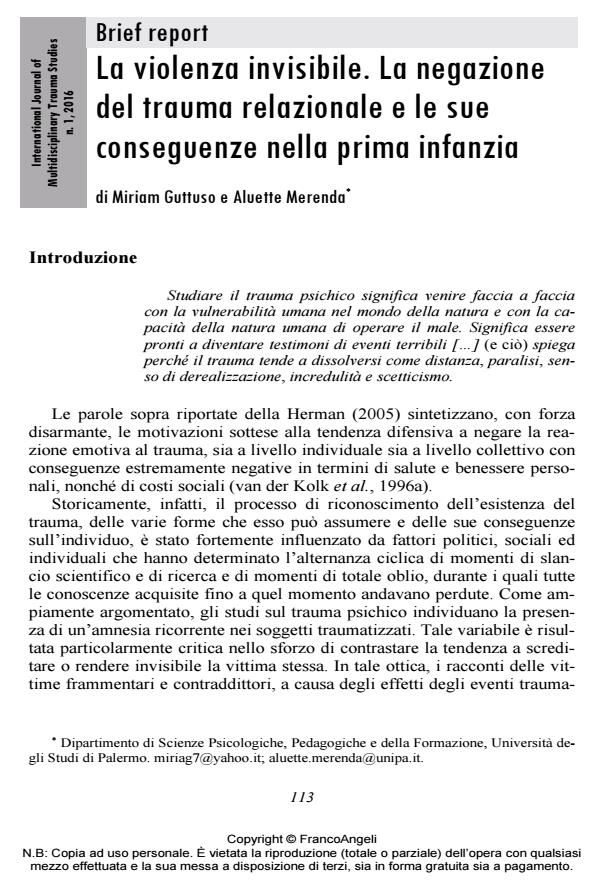The invisible violence. The denial of relational trauma and its consequences in early childhood
Journal title INTERNATIONAL JOURNAL OF MULTIDISCIPLINARY TRAUMA STUDIES
Author/s Miriam Guttuso, Aluette Merenda
Publishing Year 2016 Issue 2016/1 Language Italian
Pages 7 P. 113-119 File size 168 KB
DOI 10.3280/IJM2016-001012
DOI is like a bar code for intellectual property: to have more infomation
click here
Below, you can see the article first page
If you want to buy this article in PDF format, you can do it, following the instructions to buy download credits

FrancoAngeli is member of Publishers International Linking Association, Inc (PILA), a not-for-profit association which run the CrossRef service enabling links to and from online scholarly content.
The paper presents a theoretical analysis on the effects of the denial of childhood relational traumatic experiences. The lack of recognition of prolonged and repeated trauma and the chronic refusal to acknowledge cumulative neglect events have a direct dissociative effect on the malleable identity of a child (Bifulco e Moran, 1998) as well as on his ability to make relationships of trust (van der Kolk et al., 2007). An higher presence of trauma exposure measures to assess these types of trauma a child has been exposed to, or the degree of severity of the traumatic event experienced, could allow to prevent the stabilization of symptoms in the clinical settings (Liotti e Farina, 2011).
Keywords: Childhood, relational trauma, denial impact.
- Albasi C. (2006). Attaccamenti traumatici. I modelli operativi interni dissociati. Torino: UTET.
- Bifulco A. e Moran P. (1998). Il bambino maltrattato. Le radici della depressione nel trauma e nell’abuso infantile. Roma: Astrolabio-Ubaldini, 2007.
- Caretti V. e Craparo G. (a cura di) (2008). Trauma e psicopatologia. Un approccio evolutivo relazionale. Roma: Astrolabio-Ubaldini.
- Cicchetti D. and Toth S. (1994). Rochester symposium on developmental psychopathology: Disorders and dysfunctions of the self (Vol.5). NY: University of Rochester Press.
- Cook A., Blaustein M., Spinazzola J. and van der Kolk B.A. (2003). Complex trauma in children and adolescents. National Child Traumatic Stress Network. www.NCTSNet.org.
- Farina B. e Liotti G. (2011). Dimensione dissociativa e trauma dello sviluppo. Cognitivismo Clinico, 8(1):3-17.
- Foti C. (2007). Il negazionismo dell’abuso sui bambini, l’ascolto non suggestivo e la diagnosi possibile. Minorigiustizia, 2:262-306.
- Herman J.L. (1992a). Guarire dal trauma. Affrontare le conseguenze della violenza, dall’abuso domestico al terrorismo. Roma: Edizioni Magi, 2005.
- Herman J.L. (1992b). Complex PTSD: a syndrome in survivors of prolonged and repeated trauma. Journal of Traumatic Stress, 5(3):377-391. DOI: 10.1002/jts.2490050305
- Khan M. (1974). Lo spazio privato del Sé. Torino: Bollati Boringhieri, 1979.
- Lanius R.A., Vermetten E. and Pain C. (Eds.) (2010). L’impatto del trauma infantile sulla salute e sulla malattia. L’epidemia nascosta. Roma: Giovanni Fioriti, 2012.
- Liotti G. e Farina B. (2011). Sviluppi traumatici. Eziopatogenesi, clinica e terapia della dimensione dissociativa. Milano: Raffaello Cortina.
- Main M. and Hesse E. (1990). Parents’ unresolved traumatic experiences are related to infant disorganized attachment status: is frightened/frightening parental behavior the linking mechanism? In: Greenberg, M.T., Cicchetti, D. and Cummings E.M. (Eds.). Attachment in the preschool years: Theory, research and intervention. Chicago (US): University of Chicago Press.
- Montecchi M. (2000). Gli abusi all’infanzia. Dalla ricerca all’intervento clinico. Roma: Carocci.
- Putnam F.W. (1997). La dissociazione nei bambini e negli adolescenti: una prospettiva evolutiva. Roma: Astrolabio-Ubaldini, 2005.
- Pynoos R.S., Fairbank J.A., Steinberg A.M., Layne C.M., Briggs E.C. and Ostrowski S.A. (2009). DSM-5 PTSD diagnostic criteria for children and adolescents: A developmental perspective and recommendations. Journal of Traumatic Stress, 22(5):391-398. DOI: 10.1002/jts.20450
- van der Kolk B.A., McFarlane A.C. e Weisaeth L. (1996a). Stress traumatico. Gli effetti sulla mente, sul corpo e sulla società delle esperienze intollerabili. Roma: Magi, 2005.
- van der Kolk B.A., Pelcovitz, M.D., Roth S., Mandel F.S., McFarlane A. and Herman J.L. (1996b). Dissociation, somatization, and affect dysregulation: the complexity of adaptation of trauma. American Journal of Psychiatry, 153(7 suppl.):83-93.
- van der Kolk B.A., Roth S., Pelcovitz D., Sunday S. and Spinazzola J. (2005). Disorders of extreme stress: The empirical foundation of a complex adaptation to trauma. Journal of Traumatic Stress, 18(5):389-399.
Miriam Guttuso, Aluette Merenda, La violenza invisibile. La negazione del trauma relazionale e le sue conseguenze nella prima infanzia in "INTERNATIONAL JOURNAL OF MULTIDISCIPLINARY TRAUMA STUDIES" 1/2016, pp 113-119, DOI: 10.3280/IJM2016-001012